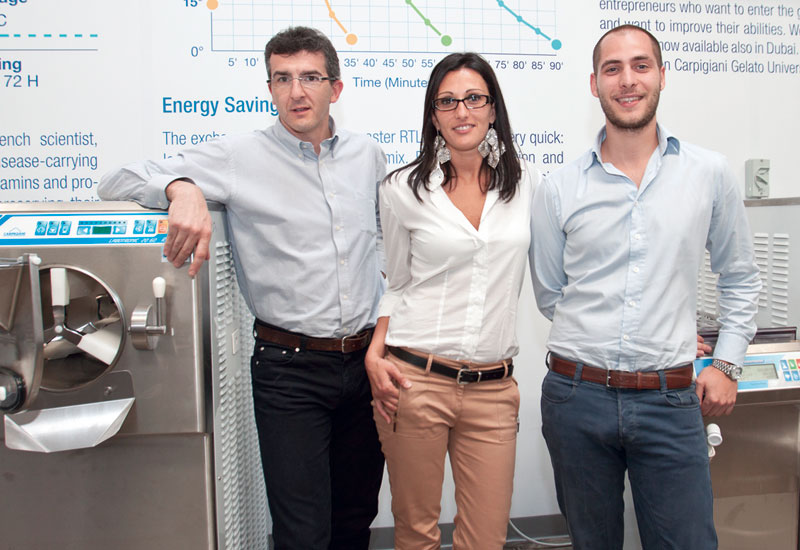 L-R:Giacomo Bonfiglioli, export manager, Carpigiani; Christina Dalla Mora, packaging sales director, Polo Point International; David Braido, project m
L-R:Giacomo Bonfiglioli, export manager, Carpigiani; Christina Dalla Mora, packaging sales director, Polo Point International; David Braido, project m
Bologna’s Gelato University has arrived in the Middle East to teach budding entrepreneurs the art of making authentic Italian gelato — just don’t mention the “i” word.
Hundreds of years before the American-style ice cream we’re all familiar with today was popular, the ancient Romans were indulging in frozen desserts made from ice and snow brought down from mountaintops and preserved below ground.
This ancient practice has evolved into the art of authentic Italian gelato, a speciality which was conspicuously absent when Cristina Dalla Mora, packaging sales director of Polo Point International, first came to the Middle East. “When we arrived in the GCC a few years ago, we noted that gelato was completely absent,” says Dalla Mora.

| Advertisement |
“Considering we came from the North Eastern Italian region, where gelato was a daily component of our life, we really missed it — the idea to bring the Gelato University here was simply born in this way.”
The Gelato University was opened in Dubai at the beginning of this year in cooperation with Carpigiani, the worldwide leader in the gelato machinery market and Bigatton Academy, leader in the gelato raw material.
“It is an international centre of learning created to expand the gelato culture across the Middle East,” explains Dalla Mora. “The main objective is to sustain the development of gelato and to create a public that appreciates the pleasure and flavour of an Italian genuine gelato.”
Gelato is distinct from ice cream in several ways and the words should not be used synonymously, says Dalla Mora: “They describe two completely different products,” she says.
“Italian gelato contains less fat than ice cream, has less incorporated air, and is served at a higher temperature. Consequently, gelato provides a greater flavour experience because there is less fat that coats the tongue, there is more flavour per spoonful due to there being less air in the product, and the taste buds are more alive since the temperature is not so cold it dulls their sensitivity.
“Another difference is that ice cream tends to be made in large industrial batches, and therefore uses ingredients designed for lengthy storage, which limits the flavours.
Authentic Italian gelato, on the other hand, is produced fresh practically every day in relatively small quantities, is sold directly to the public, and is available in a large number of flavours — usually based on fresh ingredients that make the gelato creamy and colourful.”
It is this passion for gelato which teachers such as Chef Giovannino Fittipaldi, of the Academia Gelateria Italiana, is hoping to instill in the students during the Gelato University courses.
Participants sign up for courses of three to five days for varying levels of qualifications, from beginner to advanced level.
While the original university in Bologna, Italy, attracts thousands of budding gelato entrepreneurs each year, the Dubai outlet has seen students attending from Saudi Arabia, Iran and Qatar as well as the UAE, whose purposes vary from the curious amateur eager to improve their knowledge, to professional chefs and brand representatives wanting to earn their stripes within the discipline.
“At the beginning we thought that mainly young people would come,” says Giacomo Bonfiglioli, export manager of Carpigiani.
“But we have seen that internationally, from our outlets in Italy to those in the US, Japan, elsewhere in Europe and here in Dubai, they tend to be between the ages of 35 to 45 and often come with some level of knowledge about the food and beverage industry already.”
Bonfiglioli says that the financial crisis led to a rise in students attending the gelato classes: “The crisis created opportunities for some people,” he says.
“They decided to create a new business. In Italy there are around 30,000-35,000 gelaterias and we’ve seen how keen Italians are to export the concept. There is a real opportunity in this region, where artisan gelaterias are not yet common, but awareness of the art of gelato is increasing.”
From explaining the balance of ingredients to outlining the mixture of flavours, the gelato courses aim to impart a skill, which Dalla Mora says cannot be achieved by simply having the right equipment: “It’s not enough just to have the right recipe,” she says. “You can have all the right raw materials and the best machinery and still not have the ability to make gelato authentically.”








 Search our database of more than 2,700 industry companies
Search our database of more than 2,700 industry companies









